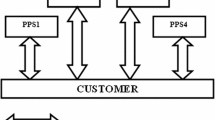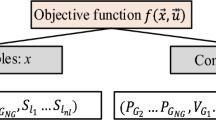Abstract
Recent power system networks are characterized by large proportions, high interconnections, and high nonlinearities. Challenge of supplying the nation with high-quality, reliable electrical energy at a reasonable cost converted government policy into deregulation and restructuring environment. To achieve significant cost-savings, multiarea unit commitment strategies are employed, whose intention is to establish the optimal commitment stratagem for power generating units situated in numerous areas which are interconnected through tie-lines, and combined operation of generation resources can result in considerable operational cost-savings. Differential evolution is a population-based stochastic search algorithm, whose simple yet powerful and straightforward features make it gorgeous for optimization. Differential evolution uses somewhat greedy and less stochastic approach for optimization problem solution. Although global exploration ability of differential evolution (DE) algorithm is adequate, its local exploitation ability is feeble and convergence velocity is too low, and it suffers from the problem of untimely convergence for multimodal objective function, in which search process may be trapped in local optima and it loses its diversity. Also, it suffers from the stagnation problem, where the search process may infrequently stop proceeding toward the global optimum even though the population has not converged to a local optimum or any other point. To improve the exploitation ability and global performance of DE algorithm, a novel and hybrid version of differential evolution algorithm combined with random search algorithm is presented in the proposed research to solve multiobjective and multiarea unit commitment problem of electric power system. The performance of the proposed hybrid algorithm is tested with benchmark of three-area interconnected system, which consist of IEEE-30 Bus system. Experimental results show that proposed technique has the prospective for the solution of multiobjective and multiarea unit commitment problem and power generation scheduling in deregulated electricity market with import and export constraints.












Similar content being viewed by others
References
Geem Z (2006) Improved harmony search from ensemble of music players. In: Gabrys B, Howlett RJ, Jain L (eds) Knowledge-based intelligent information and engineering systems. Springer, Heidelberg, pp 86–93
Kamboj VK, Bath SK, Dhillon JS (2015) Hybrid HS-random search algorithm considering ensemble and pitch violation for unit commitment problem. Neural Comput Appl 26(8). doi:10.1007/s00521-015-2114-6. ISSN: 1433-3058
Kamboj VK, Bath SK, Dhillon JS (2015)A novel hybrid DE-random search approach for unit commitment problem. Neural Comput Appl 26(8). doi:10.1007/s00521-015-2124-4. ISSN: 1433-3058
Bhattacharya K, Bollen MHJ, Dlder JE (2001) Operation of restructured power systems. Kluwer Academic Publishers, New York
Wang C, Shahidehpur SM (1992) A decomposition approach to non linear multi area generation scheduling with tie line constraints using expert systems. IEEE Trans Power Syst 7(4):1409–1418
Yingvivatanapong C (2006) Multi-area unit commitment and economic dispatch with market operation components. Ph.D. dissertation, Dept. Elect. Eng., Univ. Texas. Arlington, TX, 2006, Ch. 5 and appendixes 2–3
Yingvivatanapong C, Lee Wei-Jen, Liu Edwin (2008) Multi-area power generation dispatch in competitive markets. IEEE Trans Power Syst 23(1):196–203
Chitraselvi S, Kumudini Devi RP, Christober Asir Rajan C (2009) Multi-area unit commitment with bilateral contract approach in deregulated electricity market. J Elec Eng Tech 4(5):346–352
Chitra Selvi S, Kumudini Devi RP, Christober Asir Rajan C (2009) Hybrid evolutionary programming approach to multi-area unit commitment with import and export constraints. Int J Recent Trends Eng 1(3):223–228
Chitra Selvi SRP, Kumudini Devi RP, Christober Asir Rajan C (2009) Multi-area unit commitment using hybrid particle swarm optimization technique with import and export constraints. Engineering. doi:10.4236/eng.2009.13017. Published Online November 2009. http://www.scirp.org/journal/eng. Scientific Research 2009
Venkatesan K, Christober Asir Rajan C (2012) Ant colony search algorithm for solving multi area unit commitment problem with import and export constraints. Int J Eng Res Technol 1(8): 1–18. ISSN: 2278-0181
Chitra Selvi S, Kumudini Devi RP, Christober Asir Rajan C (2012) Multi-area unit commitment with transmission losses using evolutionary iteration particle swarm optimization approach. Eur J Sci Res 76(4): 672–691. ISSN 1450-216X
Venkatean K, Rajan CCA (2012) Improved bilateral contract approach to multiarea unit commitment in deregulated electricity. Int J Adv Eng Technol 3(2): 446–455. ISSN: 2231-1963
Kerr RH, Scheidt JL, Fontana AJ, Wiley JK (1966) Unit commitment. IEEE Trans Power Appar Syst PAS-85(5):417–421
Hara K, Kimura M, Honda N (1966) A method for planning economic unit commitment and maintenance of thermal power systems. IEEE Trans Power Appar Syst PAS-85(5):421–436
Guy JD (1971) Security constrained unit commitment. IEEE Trans Power Appar Syst 90:1385–1389
Lowery PG (1966) Generating unit commitment by dynamic programming. IEEE Trans Power Appara Syst PAS-85(5):422–426
Hobbs WJ, Hermon G, Warner S, Sheble GB (1988) An enhanced dynamic programming approach for unit commitment. IEEE Trans Power Syst 3:1201–1205
Li T, Shahidehpour M (2005) Price-based unit commitment: a case of Lagrangian relaxation versus mixed integer programming. IEEE Trans Power Syst 20(4):2015–2025
Venkatesh B, Jamtsho T, Gooi HB (2007) Unit commitment a fuzzy mixed integer linear programming solution. IET Gener Transm Distrib 1(5):836–846
Saini LM, Soni MK (2002) Artificial neural network-based peak load forecasting using conjugate gradient methods. IEEE Trans Power Syst 17(3):907–912
Guan X, Zhai Q, Papalexopoulos A (2003) Optimization based methods for unit commitment: lagrangian relaxation versus general mixed integer programming. In: Proceedings of IEEE power engineering society general meeting, Toronto, Canada, vol 2, pp 1095–1100
Cohen AI, Yoshimura M (1983) A branch-and-bound algorithm for unit commitment. IEEE Trans Power Appar Syst 102(2):444–451
Salam M-S, Hamdan A-R, Nor KM (1991) Integrating an expert system into a thermal unit-commitment algorithm. IEE proceedings- C, vol 138, pp. 553–559
Kadam DP, Sonwane PM, Dhote VP, Kushare BE (2009) Fuzzy logic algorithm for unit commitment problem. Proceedings of international conference on control, automation, communication and energy conversation (INCACEC-2009), Perundurai, Erode, India, pp 1–4
Yalcinoz T, Short MJ, Cory BJ (1999) Application of neural networks to unit commitment. IEEE Trans Power Syst 2:649–654. doi:10.1109/AFRCON.1999.821841
Simopoulos D, Contaxis G (2004) Unit commitment with ramp rate constraints using the simulated annealing algorithm. Proceedings of IEEE mediterranean electrotechnical conference (MELECON 2004), Dubrovnik, Croatia, pp 845–849
Mantawy AH, Abdel-Magid YL, Selim SZ (1998) Unit commitment by tabu search. IEE Proc Gener Trans Distrib 145(1):56–64
Mirjalili Seyedali, Lewis Andrew (2014) Adaptive gbest-guided gravitational search algorithm. Neural Comput Appl 25(7–8):1569–1584
Kerr RH, Scheidt JL, Fontana AJ, Wiley JK (1966) Unit commitment. IEEE Trans Power Appar Syst PAS-85(5):417–421
Storn R, Price K (1995) Differential evolution—a simple and efficient adaptive scheme for global optimization over continuous spaces. Technical Report TR-95-012, Berkeley, CA
Storn R, Price K (1997) Differential evolution—a simple and efficient heuristic for global optimization over continuous spaces. J Global Optim 11(4):341–359
Author information
Authors and Affiliations
Corresponding author
Appendix
Appendix
Rights and permissions
About this article
Cite this article
Kamboj, V.K., Bath, S.K. & Dhillon, J.S. Multiobjective multiarea unit commitment using hybrid differential evolution algorithm considering import/export and tie-line constraints. Neural Comput & Applic 28, 3521–3536 (2017). https://doi.org/10.1007/s00521-016-2240-9
Received:
Accepted:
Published:
Issue Date:
DOI: https://doi.org/10.1007/s00521-016-2240-9




